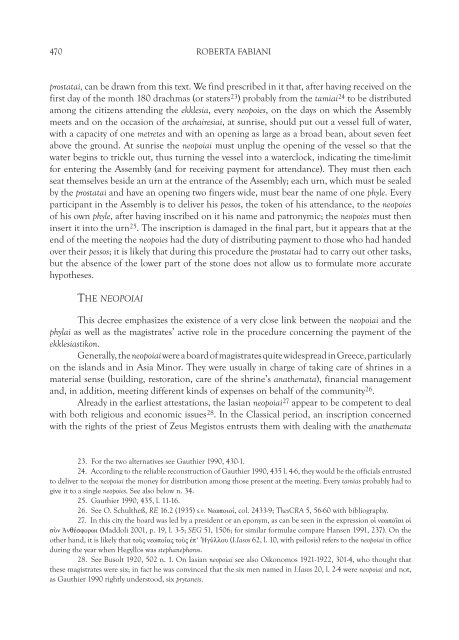hellenistic karia - Associazione Iasos di Caria
hellenistic karia - Associazione Iasos di Caria
hellenistic karia - Associazione Iasos di Caria
You also want an ePaper? Increase the reach of your titles
YUMPU automatically turns print PDFs into web optimized ePapers that Google loves.
470 ROBERTA FABIANI<br />
prostatai, can be drawn from this text. We find prescribed in it that, after having received on the<br />
first day of the month 180 drachmas (or staters 23 ) probably from the tamiai 24 to be <strong>di</strong>stributed<br />
among the citizens atten<strong>di</strong>ng the ekklesia, every neopoies, on the days on which the Assembly<br />
meets and on the occasion of the archairesiai, at sunrise, should put out a vessel full of water,<br />
with a capacity of one metretes and with an opening as large as a broad bean, about seven feet<br />
above the ground. At sunrise the neopoiai must unplug the opening of the vessel so that the<br />
water begins to trickle out, thus turning the vessel into a waterclock, in<strong>di</strong>cating the time-limit<br />
for entering the Assembly (and for receiving payment for attendance). They must then each<br />
seat themselves beside an urn at the entrance of the Assembly; each urn, which must be sealed<br />
by the prostatai and have an opening two fingers wide, must bear the name of one phyle. Every<br />
participant in the Assembly is to deliver his pessos, the token of his attendance, to the neopoies<br />
of his own phyle, after having inscribed on it his name and patronymic; the neopoies must then<br />
insert it into the urn 25 . The inscription is damaged in the final part, but it appears that at the<br />
end of the meeting the neopoies had the duty of <strong>di</strong>stributing payment to those who had handed<br />
over their pessos; it is likely that during this procedure the prostatai had to carry out other tasks,<br />
but the absence of the lower part of the stone does not allow us to formulate more accurate<br />
hypotheses.<br />
the neopoiai<br />
This decree emphasizes the existence of a very close link between the neopoiai and the<br />
phylai as well as the magistrates’ active role in the procedure concerning the payment of the<br />
ekklesiastikon.<br />
Generally, the neopoiai were a board of magistrates quite widespread in Greece, particularly<br />
on the islands and in Asia Minor. They were usually in charge of taking care of shrines in a<br />
material sense (buil<strong>di</strong>ng, restoration, care of the shrine’s anathemata), financial management<br />
and, in ad<strong>di</strong>tion, meeting <strong>di</strong>fferent kinds of expenses on behalf of the community 26 .<br />
Already in the earliest attestations, the Iasian neopoiai 27 appear to be competent to deal<br />
with both religious and economic issues 28 . In the Classical period, an inscription concerned<br />
with the rights of the priest of Zeus Megistos entrusts them with dealing with the anathemata<br />
23. For the two alternatives see Gauthier 1990, 430-1.<br />
24. Accor<strong>di</strong>ng to the reliable reconstruction of Gauthier 1990, 435 l. 4-6, they would be the officials entrusted<br />
to deliver to the neopoiai the money for <strong>di</strong>stribution among those present at the meeting. Every tamias probably had to<br />
give it to a single neopoies. See also below n. 34.<br />
25. Gauthier 1990, 435, l. 11-16.<br />
26. See O. Schultheß, RE 16.2 (1935) s.v. Νεωποιοί, col. 2433-9; ThesCRa 5, 56-60 with bibliography.<br />
27. In this city the board was led by a president or an eponym, as can be seen in the expression οἱ νεωποῖαι οἱ<br />
σὺν Ἀνθέσφορωι (Maddoli 2001, p. 19, l. 3-5; SEG 51, 1506; for similar formulae compare Hansen 1991, 237). On the<br />
other hand, it is likely that τοὺς νεωποίας τοὺς ἐπ’ ëHγύλλου (I.<strong>Iasos</strong> 62, l. 10, with psilosis) refers to the neopoiai in office<br />
during the year when Hegyllos was stephanephoros.<br />
28. See Busolt 1920, 502 n. 1. On Iasian neopoiai see also Oikonomos 1921-1922, 301-4, who thought that<br />
these magistrates were six; in fact he was convinced that the six men named in I.<strong>Iasos</strong> 20, l. 2-4 were neopoiai and not,<br />
as Gauthier 1990 rightly understood, six prytaneis.



